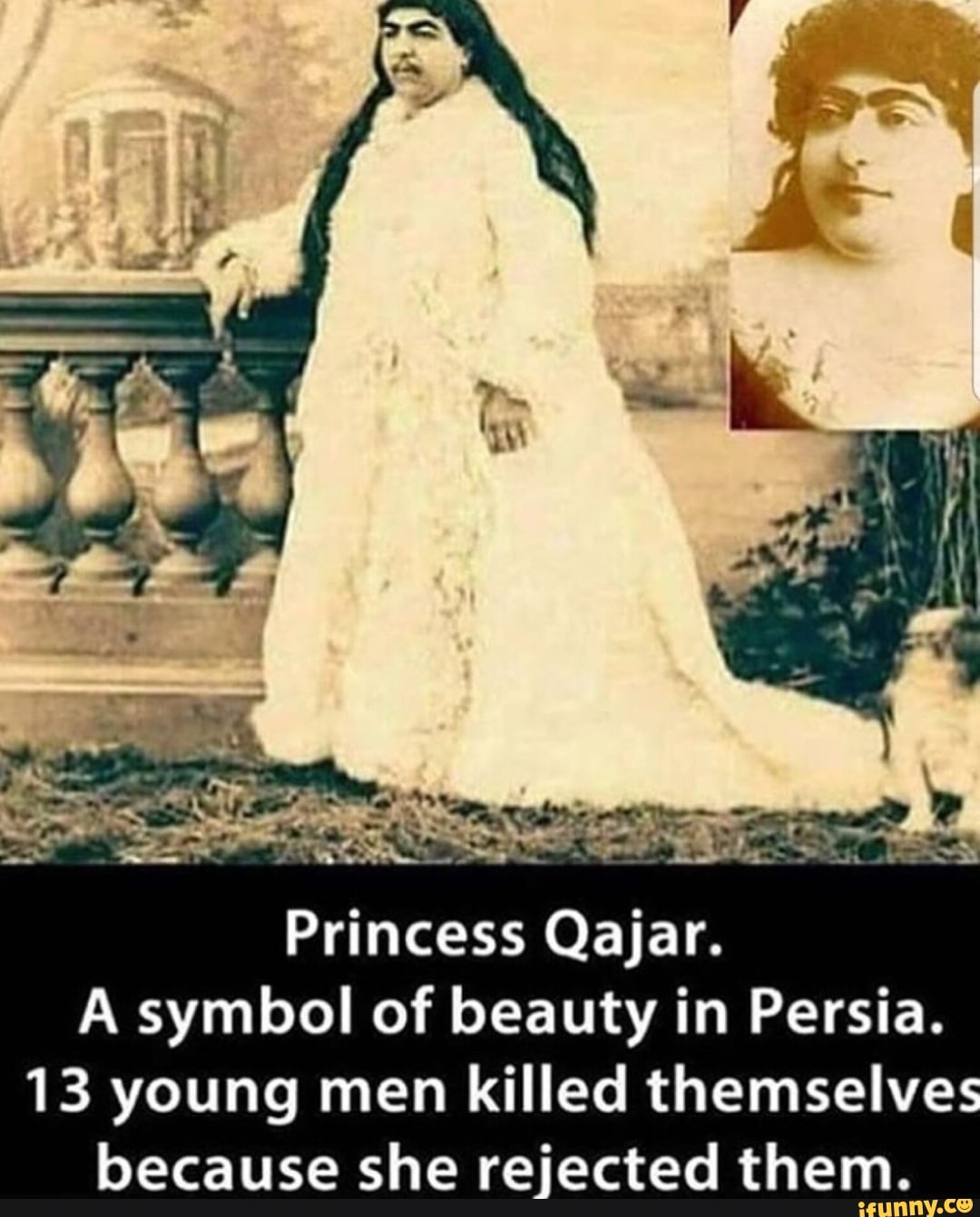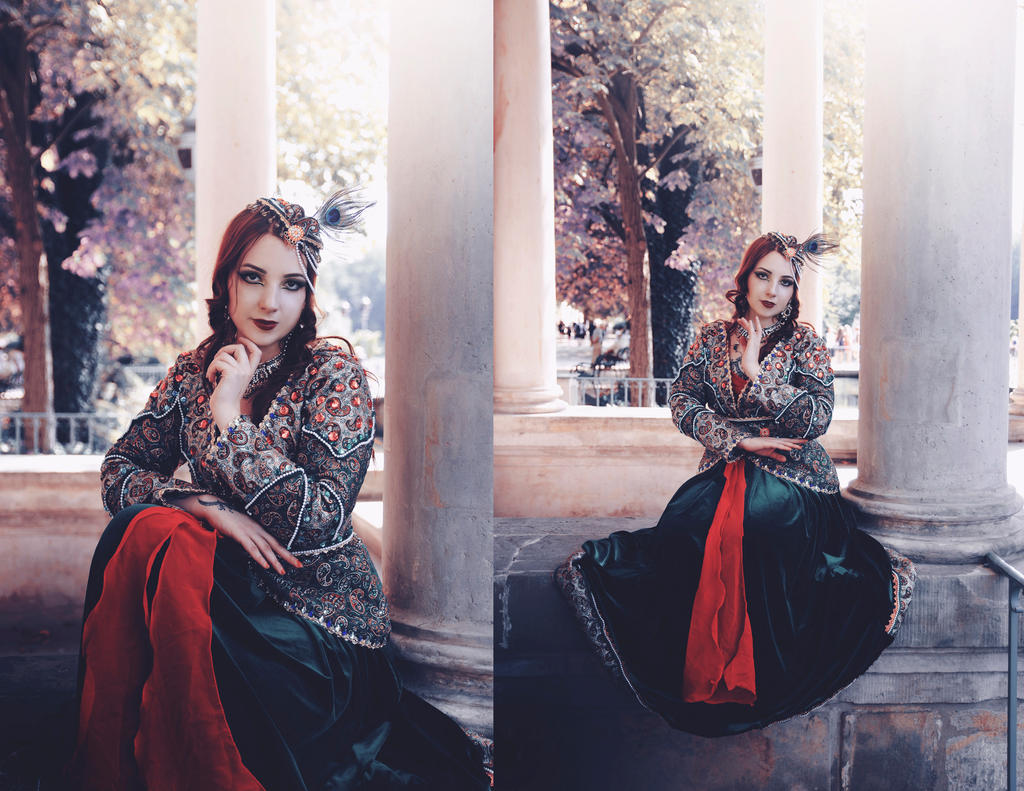So, you know, it's almost like a riddle, isn't it? You've probably seen those really striking images floating around the internet, showing a 19th-century Persian princess with, well, a rather distinct appearance, often with a little bit of facial hair. These pictures, you know, they've sparked a lot of chatter, and they've actually become a pretty popular meme, often with some wild stories attached to them.
It's fascinating, isn't it, how certain images can just take on a life of their own online? This particular Princess Qajar story, it's a great example of how history, or what people think is history, can get all tangled up with viral claims and, frankly, a bit of what we might call "junk history." There's this idea that she was so beautiful, so enchanting, that she drove numerous men to despair, even to suicide, which, you know, sounds dramatic, doesn't it?
But here's the thing: while the images are certainly real, the sensational tales that go along with them are, in fact, mostly made up. This article is going to take a closer look at the actual facts behind the Princess Qajar story, separating the truth from the internet's playful, yet often misleading, narratives. We'll explore who this woman really was, the historical period she lived in, and how her image became such a widespread, sometimes misunderstood, symbol.
Table of Contents
- Uncovering the Real Princess Qajar
- The Qajar Dynasty: A Time of Change
- The Truth Behind the Viral Memes
- Fashion and Beauty Standards of the Qajar Era
- Why the Princess Qajar Story Still Captivates Us
- Frequently Asked Questions About Princess Qajar
Uncovering the Real Princess Qajar
So, when people talk about "Princess Qajar," it's actually, you know, a bit of a general term that often gets applied to a specific woman from the Qajar dynasty. This dynasty, as a matter of fact, ruled over Iran, or Persia as it was known, from the late 1700s right up until the 1920s. The woman most commonly associated with these viral photos is Princess Fatemeh Khanum "Esmat al-Dowleh," a daughter of Naser al-Din Shah Qajar, who was the Shah of Iran for a very long time.
It's important to remember that the title "princess" itself comes to English, in a way, from Old French and, you know, ultimately from Latin's "princeps." It simply refers to the daughter of a monarch or a female royal. Esmat al-Dowleh was, by all accounts, a significant figure in her time, not just some random royal. She was, you know, a real person with a real life, real responsibilities, and a real family.
Personal Details & Biography of Princess Fatemeh Khanum "Esmat al-Dowleh"
| Detail | Information |
|---|---|
| Full Name | Fatemeh Khanum "Esmat al-Dowleh" |
| Title | Princess (daughter of the Shah) |
| Dynasty | Qajar Dynasty |
| Father | Naser al-Din Shah Qajar (Shah of Iran) |
| Reign of Dynasty | Circa 1700s to 1920s (Qajar Dynasty) |
| Spouse | Dost Mohammad Khan Mo'ayyer al-Mamalek |
| Known For | Being a daughter of Naser al-Din Shah; frequently misidentified in viral memes |
| Physical Appearance | Often depicted with characteristics that were considered beautiful at the time, including a unibrow and a faint mustache. |
It's rather interesting how, you know, the internet has taken bits and pieces of her life and woven them into something else entirely. The truth behind the photos of the woman known as "Princess Qajar" isn't, you know, quite what the memes suggest. She was a real person, a princess of the Qajar royal family, and her background and origins have been the subject of much fascination and intrigue for historians and scholars, who have really looked into her story.
- Katharine Mcphee Leaked Nude
- Capricorn Pluto 2024
- Bryce Dickey
- Dawn Wells Topless Nipples
- Brandon Chappell Joe Exotic Son
The Qajar Dynasty: A Time of Change
The Qajar dynasty, which, you know, the princess belonged to, reigned over Iran for a significant period, stretching from the 1700s right up until the 1920s. This was a time of huge shifts for Iran, a period when the country was, in a way, opening up more to Western influences. Before the Qajar era, the typical dress code in Iran was, basically, limited to local cultures and traditions.
However, as a matter of fact, due to the Qajar kings' travels to Western countries, especially to Europe, things started to change. They brought back new ideas, new fashions, and new ways of doing things. This had a pretty big impact on, you know, the royal court and, eventually, on wider society. The Princess Qajar dress code, you could say, started to reflect some of these foreign influences, though it still kept many traditional Persian elements.
It's rather like a blending of worlds, isn't it? The Qajar era saw the introduction of photography, which is why we have so many images from that time, including those of Princess Esmat al-Dowleh. These photos offer a fascinating glimpse into the history and culture of Iran during that particular dynasty. They show us, you know, what life was like for the royals and how their world was slowly, but surely, changing.
The Truth Behind the Viral Memes
Now, about those Princess Qajar memes. They've been, you know, making the rounds on the internet for a really long time. Typically, they come with some rather bold claims, like the one about her being so incredibly beautiful that she drove 13 men to, you know, take their own lives. Today, we're going to, basically, debunk that claim, as there's no actual documentation that suitors committed suicide over her, or any other princess for that matter.
This "junk history" is, arguably, embodied perfectly in these recent viral memes. They portray a 19th-century Persian princess with facial hair, alongside the completely unfounded claim about her beauty causing such despair. The document we have discusses this viral meme, showing a Persian woman inaccurately portrayed as a beauty symbol in the 19th century, with these dramatic stories attached.
It's important to find out the real truth behind Princess Qajar and how she became, you know, this kind of symbol of Persia, albeit a misunderstood one. We need to see what is fake and what is real about the princess who was called "Princess Qajar" in these online narratives. The woman in the photos is indeed a real person, but the stories about her driving men to suicide are, quite simply, not true. It's a sensationalized tale that has, you know, just caught fire online.
Fashion and Beauty Standards of the Qajar Era
What's really interesting about the images of Princess Qajar, or rather, Princess Esmat al-Dowleh, is how they reflect the beauty standards of her time. In 19th-century Qajar Iran, feminine beauty ideals were, actually, quite different from what many in the Western world might consider beautiful today. For instance, a unibrow was, in a way, seen as a sign of beauty, and a faint mustache was also considered attractive.
This is why, you know, when people see these historical photos without knowing the cultural context, they might be surprised. The dress code, too, underwent changes. As mentioned, before the Qajar era, clothing was very much tied to local cultures. But gradually, as a result of the Qajar kings' foreign travels to Western countries, new styles began to appear. These included shorter skirts, which were a bit of a novelty at the time, inspired by European ballet dancers.
So, the way Princess Esmat al-Dowleh dressed and the features she had were, basically, considered very fashionable and attractive during her period. It's a reminder that beauty is, you know, very much in the eye of the beholder and, importantly, it's shaped by culture and time. The photos give us a pretty good idea of what was considered appealing in that particular historical setting.
Why the Princess Qajar Story Still Captivates Us
The story of the Persian Princess Qajar, even with all the myths, still provides a rather fascinating glimpse into the history and culture of Iran during the Qajar dynasty. It shows us how historical figures can become, you know, subjects of intrigue and how their images can be reinterpreted over time, especially with the rise of the internet and viral content.
People are, you know, naturally curious about royalty and historical figures, and when a story like this comes along, it really captures the imagination. The fact that it involves a beautiful princess, a powerful dynasty, and a dramatic, albeit fake, tale of heartbroken suitors, just makes it, you know, all the more compelling. It taps into our desire for stories that are larger than life.
This enduring interest also highlights the importance of historical accuracy. While it's fun to share memes, it's also, arguably, crucial to understand the real history behind them. The "Princess Qajar" wiki entries and other historical resources are, basically, trying to set the record straight, giving us the actual biography, family details, and background of the person in the photos, separating fact from online fiction. Learn more about history on our site, and link to this page to explore other historical figures.
The story serves as a good reminder to, you know, always question what we see online and to look for reliable sources. You can, for instance, check out academic resources or reputable history sites for a more complete picture. For more details on the Qajar dynasty and their cultural impact, you might find information on sites like the Encyclopædia Iranica very helpful.
Frequently Asked Questions About Princess Qajar
So, you know, people often have a lot of questions about this fascinating figure. Here are some common ones, with answers based on what we've discussed:
Was Princess Qajar really so beautiful that men committed suicide over her?
No, actually, that's a very popular myth that has spread online, but it's completely untrue. There is, you know, no historical documentation or evidence to suggest that any men committed suicide over Princess Esmat al-Dowleh, or any other princess from that era. It's a dramatic story, but it's just not based in fact.
Who was the real Princess Qajar in the viral photos?
The woman most often seen in the viral "Princess Qajar" photos is Princess Fatemeh Khanum "Esmat al-Dowleh." She was, basically, a daughter of Naser al-Din Shah Qajar, who was the Shah of Iran for a very long time during the 19th century. So, you know, she was a real person, a royal from the Qajar dynasty.
What were the beauty standards like during the Qajar era?
During the Qajar dynasty, beauty standards were, you know, quite different from today's Western ideals. Features like a unibrow and a faint mustache were, actually, considered very attractive and fashionable for women. This is why the appearance of Princess Esmat al-Dowleh in the photos might seem, you know, a bit unusual to modern eyes, but it was very much in line with the beauty norms of her time.
Related Resources:
:strip_icc():format(webp)/kly-media-production/medias/3012022/original/096090600_1578043955-Cek_Fakta_2.jpg)


Detail Author:
- Name : Fern Mitchell
- Username : flindgren
- Email : konopelski.xander@gutmann.net
- Birthdate : 2003-08-13
- Address : 997 Catherine Views Suite 099 Lavonnechester, VT 06222
- Phone : +1-206-994-3712
- Company : Johns, Bins and Rau
- Job : Sawing Machine Setter
- Bio : Dignissimos quia iste alias. Fugiat illum iure ex facilis. Sequi facilis labore et et molestiae nisi et. Est aut placeat est aut ut. Illum porro pariatur expedita repudiandae inventore.
Socials
facebook:
- url : https://facebook.com/hal_lesch
- username : hal_lesch
- bio : Repudiandae explicabo sint commodi sed omnis in. Porro debitis sed veniam aut.
- followers : 2038
- following : 1818
linkedin:
- url : https://linkedin.com/in/hal_real
- username : hal_real
- bio : Consequatur quia neque eligendi placeat.
- followers : 6499
- following : 1561